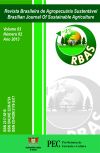EVOLUTION OF HERBACEOUS SAVANNA IN CAATINGA AREA UNDER GRAZING
DOI:
https://doi.org/10.21206/rbas.v3i2.216Abstract
The objective of this research was to evaluate the effect of goat grazing on the structure of six species of herbaceous: Cyperus uncinulatus Schrad ex. Nees, Paspalum scutatum Nees ex. Trin, Diodia sp., Aristida adscensionis L., Chamaecrista desvauxii (Collad) Killip and Evolvulus filipes Mart. and total coverage on the ground in the Caatinga, northeastern of Brazil. The experiment was conducted at the Experimental Farm School/UFPB in São João do Cariri-PB in three contiguous areas during the year 2008. The treatments consisted of three stocking rates divided into three paddocks: 3.1 an/ha; 1.5 an/ha and 0 an/ha (control). To analyze the structure of herbaceous species it was monitored the coverage of species in 30 plots of 1 m2 per treatment, totaling 90 plots sampled. The total soil coverage was monitored in these plots, in a total of 23 readings. The ground cover decrease due to the consumption of herbaceous species in the rainy season, reducing the frequency of species except Aristida adscensionis L. and Evolvulus filipes Mart. that were more persistent at grazing. The species monitored were sensitive to pulses of precipitation, sufficient to trigger a physiological response in terms of plant growth and development.Downloads
Download data is not yet available.
Downloads
Published
2013-12-30
How to Cite
Henrique Nunes Parente2, Divan Soares da Silva3, Alberício Pereira de Andrade3, Kallianna Dantas Araújo4, Bruno Leal Viana5, Michelle de Oliveira Maia Parente2, & Tobyas Maia de Albuquerque Mariz6. (2013). EVOLUTION OF HERBACEOUS SAVANNA IN CAATINGA AREA UNDER GRAZING. Brazilian Journal of Sustainable Agriculture, 3(2). https://doi.org/10.21206/rbas.v3i2.216
Issue
Section
Artigos
License
1. Proposta de Política para Periódicos de Acesso Livre
Autores que publicam nesta revista concordam com os seguintes termos:
Autores mantém os direitos autorais e concedem à revista o direito de primeira publicação, com o trabalho simultaneamente licenciado sob a Licença Creative Commons Attribution que permite o compartilhamento do trabalho com reconhecimento da autoria e publicação inicial nesta revista.











